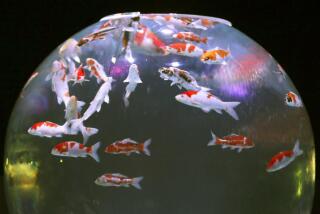Sea Urchins Are Prized Abroad
- Share via
Question: At a Japanese buffet restaurant that we frequently go to, a baked seafood dish was served that tasted strangely different to us. It had a somewhat coarse or grainy texture. The waiter said it was uni , which I found out later was the translation for sea urchin. Picturing a sea urchin with sharp spines, I cannot visualize getting anything edible from this creature. Can you please tell us more about this seafood, its safety and nutritional value?
Answer: Marketed as sea urchin roe, sea eggs or uni in Japanese, this seafood product from the spiny echinoderm is still almost unknown to many Americans. Prized as a great delicacy in Japan, France, Italy and the West Indies, sea urchins weigh from 1 to 5 pounds and are available in green or greenish-purple, red and purple color species.
Actually, the only part of the animal that is eaten are the gonads (inaccurately marketed as roe), or reproductive organs, which include both female ovaries (yellow) and male testes (orange). They are of best quality during the spawning season, which varies according to location. Most red urchins, one of the largest urchin species caught in Southern California, spawn in spring, whereas green urchins found on eastern shores tend to do so in the summer.
Aside from the spawning condition, the diet of the urchins, usually kelp, also affects the flavor quality of the seafood. When buying, freshness is important for safety. Select firm, bright orange or yellow uni with no unpleasant odor or brown blotches. Frozen products tend to have coarse texture, so they’re best used in sauces or puree for souffles. In Japanese cookery, uni may be wrapped in dried seaweed. Urchin roe is best served fresh like oysters. Scoop the roe from the shell, rinse, chill and serve in the empty shells. Accompany with lemon or lime wedges, crusty bread and well-chilled white wine.
A 3 1/2-ounce serving of sea urchin roe contains 9 grams protein, 3 grams fat and 68 calories.
Q: A Valentine’s Day story in one paper and a recent radio commercial for a restaurant chain refer to a chocolate truffle. My dictionary describes a truffle as “any number of related fleshy, edible, potato-shaped, ascomycetous fungi that grow underground . . .”
A chocolate fungus? Yuk! Perhaps it’s trifle. Thank you for straightening me out on this trifle.
A: You were right about the definition of truffles, but truffles is a term adopted by the chocolate world. Pam Williams, co-author of a cookbook called “Au Truffles” (Stein & Day: $10.95), describes truffles: “Technically and historically, a truffle is a combination of chocolate lightened with eggs, butter or cream and then flavored. Developed by a French chef it was originally rolled in cocoa in a free form shape that resembled the black fungus truffle from which it got its name.”
In their book, Williams and co-author Rita Morin give recipes for classic truffles, truffles flavored with fruit, spices, espresso and nuts as well as liquor-laced truffles. They suggest that softer and moister truffles (those made with more butter or more liquid such as milk, cream or liqueur) should be dipped in melted chocolate or refrigerated.
Q: Can you please tell me what the fell in lamb means?
A: The fell refers to the paperlike covering on lamb. Some people remove it from leg roasts, but it should be left intact as it helps to retain the shape of the meat and speeds cooking. Steaks and chops don’t usually have the fell; it is taken out by retail butchers in markets.
Address questions on food preparation to You Asked About, Food Section, The Times, Times Mirror Square, Los Angeles 90053. Personal replies cannot be given.
More to Read
Eat your way across L.A.
Get our weekly Tasting Notes newsletter for reviews, news and more.
You may occasionally receive promotional content from the Los Angeles Times.







